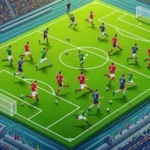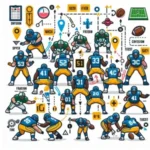In the dynamic world of modern soccer, the role of the goalkeeper has undergone a remarkable transformation, evolving far beyond the traditional perception of a mere last line of defense.
No longer confined to simply stopping shots on goal, today’s keepers are integral to their teams’ overall tactical strategies, acting as playmakers and vital contributors to the game’s flow. With the rise of possession-based football and the emphasis on building attacks from the back, goalkeepers are now expected to possess exceptional ball-handling skills, quick decision-making abilities, and an understanding of positional play that rivals that of outfield players. As we delve into the multifaceted role of the modern goalkeeper, we will explore how their contributions extend beyond shot-stopping, examining their influence on team dynamics, their evolving skill sets, and the strategic importance they hold in shaping the beautiful game. Join us as we celebrate the goalkeepers who are redefining their position and becoming key players in soccer’s tactical landscape.
1. Introduction: The Changing Landscape of Soccer
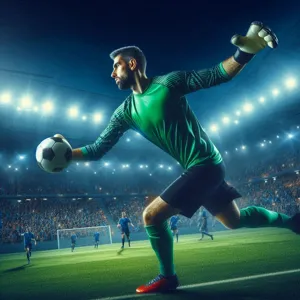
The game of soccer has undergone a profound transformation over the past few decades, evolving from a sport dominated by rigid formations and a clear separation of roles to one that embraces fluidity and versatility. At the heart of this evolution lies the goalkeeper—once primarily seen as the last line of defense, now emerging as a pivotal player in a team’s overall strategy. In modern soccer, goalkeepers are no longer confined to their 18-yard box; they have become integral to the fluid dynamics of the game, contributing not just through saves and shot-stopping, but also through their involvement in build-up play and tactical organization.
With the increasing emphasis on possession-based football, goalkeepers are now expected to be comfortable with the ball at their feet, capable of initiating attacks with precise distribution and quick decision-making. They are called upon to read the game, anticipate plays, and act as a first point of contact in transitioning from defense to offense. As teams opt for a high-pressing style, the goalkeeper’s role expands further, requiring them to engage in sweeper-keeper duties—an art that combines agility, speed, and a keen sense of positioning.
Moreover, the rise of analytics in soccer has redefined the goalkeeper’s impact on the game. Data-driven insights shape training regimens and match strategies, allowing them to optimize their performance and make informed decisions in real-time. This shift not only enhances their individual capabilities but also elevates the team’s overall effectiveness on the pitch.
In this blog post, we will delve deeper into the evolving responsibilities of the modern goalkeeper, exploring how they have transcended traditional expectations to become dynamic playmakers and crucial tactical assets in today’s beautiful game. Join us as we examine the skills, mentality, and strategic importance of goalkeepers in the contemporary soccer landscape.
2. Historical Perspective: The Traditional Role of the Goalkeeper
To truly appreciate the evolving role of the goalkeeper in modern soccer, we must first delve into a historical perspective that highlights their traditional responsibilities. In the early days of the sport, the goalkeeper was often viewed as little more than a last line of defense—a solitary figure stationed between the posts, tasked primarily with stopping shots on goal. Clad in distinct colors to set them apart from their teammates, these early custodians were primarily reactive players, relying on instinct and physical prowess to fend off opposing attacks.
Historically, the role was characterized by a lack of specialization. Goalkeepers were often former outfield players, and their skill set revolved around making crucial saves and organizing the defense. Their footwork was limited, with a focus on catching and parrying shots rather than playing the ball with their feet. This approach reflected the game’s overall tactical mindset, where the emphasis was placed on physicality and direct play, rather than the nuanced strategies we see today.
As the game progressed through the 20th century, the introduction of new rules—such as the back-pass law in the 1990s—began to reshape the role of the goalkeeper. Suddenly, they were no longer just shot-stoppers; they were required to be more active participants in the build-up play, necessitating a greater level of skill with their feet. This shift marked the beginning of a transformation that would redefine the position entirely.
In essence, the traditional role of the goalkeeper was limited to defensive responsibilities, with little emphasis on playmaking or tactical involvement. However, this is no longer the case. As we explore the modern game, it becomes clear that goalkeepers are now integral to their teams’ attacking strategies, functioning as pivotal players who must possess a diverse skill set, including excellent distribution, tactical awareness, and even the ability to read the game like an outfield player. The evolution from a solitary protector to a dynamic playmaker underscores the dramatic changes in soccer—changes that continue to shape how we perceive the role of the goalkeeper today.
3. The Goalkeeper as a Shot Stopper: Skills and Techniques

In the fast-paced world of modern soccer, the role of the goalkeeper has transformed dramatically, evolving far beyond merely being a last line of defense. A crucial aspect of this evolution is the goalkeeper’s primary function as a shot stopper. Mastering the skills and techniques involved in this role is essential, as it can mean the difference between victory and defeat for a team.
At the heart of shot-stopping is the ability to anticipate the trajectory of the ball. Modern goalkeepers must possess an acute sense of awareness, quickly reading the game to predict where the shot will come from and how to position themselves accordingly. This requires not only sharp reflexes but also exceptional agility. The best goalkeepers are often seen executing remarkable dives, reaching for shots that seem impossible to save. These acrobatic feats stem from rigorous training, where drills focus on improving lateral movement and explosive power.
Another critical skill is the goalkeeper’s handling ability. A confident keeper can snatch the ball from the air or secure low-driven shots with both hands, minimizing the risk of rebounds—a crucial aspect in high-pressure situations. Additionally, the technique of “parrying” or deflecting the ball can be vital for keeping the ball out of the net while directing it away from danger, showcasing the goalkeeper’s tactical awareness.
Footwork is equally important. In an era where goalkeepers are expected to contribute to the build-up play, precise footwork can be the difference between a successful distribution and a turnover. Modern shot stoppers often utilize techniques such as quick step-overs or shuffles to position themselves effectively, enabling rapid response to incoming shots while maintaining balance and control.
Moreover, mental fortitude cannot be overlooked. A goalkeeper must remain composed under pressure, especially during penalty shootouts or in tightly contested matches. The mental game involves not only self-confidence but also the ability to remain focused amidst chaos, ensuring that even after conceding a goal, they can quickly reset and maintain their performance level.
In summary, the goalkeeper as a shot stopper embodies a blend of physical skills, psychological resilience, and tactical understanding. As the game continues to evolve, so too will the techniques and responsibilities of goalkeepers, solidifying their role not just as defenders but as integral players in the overall strategy of the game.
4. The Rise of the “Sweeper Keeper”: A New Tactical Approach
The rise of the “sweeper keeper” has fundamentally transformed how we perceive the role of goalkeepers in modern soccer. Gone are the days when a goalkeeper was merely a shot-stopper, rooted to their line and tasked solely with preventing the opposition from scoring. Today’s goalkeepers are dynamic playmakers, engaging actively in the flow of the game and often venturing beyond the penalty area to contribute to their team’s attacking strategies.
At the heart of this tactical evolution lies the need for goalkeepers to be adept with their feet, demonstrating exceptional ball control and vision. The sweeper keeper is not only responsible for saving shots but also for initiating plays from the back. With their ability to read the game, they can provide crucial support in building attacks, acting as an additional defender who can intercept through balls and clear potential threats while maintaining fluidity in the team’s formation.
Clubs like Manchester City, under Pep Guardiola, have epitomized this shift by employing goalkeepers who are comfortable with the ball at their feet. Ederson, for example, is renowned for his pinpoint passing and ability to launch counter-attacks from deep within his penalty area. His presence allows defenders to push higher up the pitch, knowing they have a reliable outlet behind them. This tactical approach not only enhances the team’s defensive stability but also adds an unpredictable layer to their offensive play.
Moreover, the sweeper keeper’s role extends beyond technical skills; it requires a strong psychological mindset. They must possess the confidence to make split-second decisions about when to engage opponents outside the box or retreat to their goal line. This duality of responsibilities—acting as both a defender and a playmaker—places immense pressure on modern goalkeepers but also rewards those who can master it.
As we continue to witness the evolution of soccer tactics, the sweeper keeper has become a vital part of a team’s overall strategy, reshaping the traditional expectations of the position. This new breed of goalkeeper is redefining what it means to guard the net, proving that they are much more than just the last line of defense—they are integral to the very fabric of the game.
5. Distribution and Playmaking: Goalkeepers as Playmakers
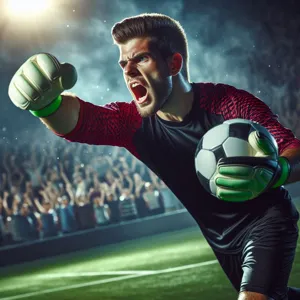
In the modern game of soccer, the role of the goalkeeper has transcended traditional boundaries, evolving from merely a last line of defense to a pivotal playmaker on the pitch. No longer satisfied with simply stopping shots and organizing the defense, today’s goalkeepers are increasingly tasked with initiating attacks and aiding in ball distribution, making them integral to their team’s overall strategy.
Goalkeepers like Alisson Becker and Ederson Moraes have become prime examples of this transformation, showcasing remarkable footwork and passing accuracy that rival many midfielders. Their ability to deliver precise, long-range passes or quick, short balls can either break the opposition’s press or create scoring opportunities. With every game, they demonstrate that a well-timed distribution can shift the momentum in an instant, turning defensive situations into counter-attacks.
Moreover, modern formations often place goalkeepers in situations akin to a quarterback in football, where they must read the game, anticipate movements, and make split-second decisions. The best keepers are not just shot-stoppers; they possess an acute awareness of their teammates’ positioning and the opponent’s tactics, allowing them to dictate the pace and flow of the game. Whether it’s a swift throw to a wing-back or a calculated goal kick aimed at a forward, their contributions extend far beyond the penalty area.
This shift has also influenced training methodologies, with coaches investing time in developing a goalkeeper’s technical skills and tactical understanding. Drills now often include scenarios that emphasize passing under pressure, playing out from the back, and even participating in small-sided games to enhance their overall game awareness.
As soccer continues to evolve, the goalkeeper’s role as a playmaker will only grow more significant, redefining their position on the field and challenging traditional perceptions of what it means to be a custodian of the goal. Embracing this dual responsibility not only enriches their own skill set but also enhances the team’s dynamics, making them a crucial asset in the quest for success on the soccer field.
6. The Importance of Communication: Organizing the Defense
In the ever-evolving landscape of modern soccer, the goalkeeper’s role transcends mere shot-stopping; they have become crucial orchestrators of the team’s defensive strategy. One of the most vital aspects of this transformation is the importance of communication. A successful goalkeeper is not only tasked with guarding the goal but also with organizing the defensive line, ensuring that their teammates are aligned and prepared for the challenges they face from opposing attackers.
Imagine a scenario where a striker is charging toward the goal, the crowd holding its breath in anticipation. In that split second, it’s the goalkeeper who must issue clear and authoritative commands, directing defenders to mark opponents, drop back, or press forward. Their vocal presence can instill confidence, guiding defenders through the chaos of high-stakes moments. A well-timed shout or hand signal can mean the difference between a crucial save and a goal conceded.
Moreover, effective communication extends beyond direct interactions during open play. Goalkeepers are responsible for reading the game and anticipating threats, often spotting potential issues before they unfold. By constantly vocalizing their observations—pointing out unmarked players, identifying gaps in the defensive structure, or calling for a higher line—they play a pivotal role in shaping the overall defensive strategy. This proactive approach not only helps to maintain organization but also fosters a sense of unity and purpose among the defenders.
Practices that emphasize communication skills have become integral to goalkeeper training. Coaches are increasingly focusing on developing their keepers’ ability to communicate under pressure, employing drills that simulate game situations where rapid-fire decisions and instructions are essential. This rigorous preparation equips goalkeepers to assert themselves as leaders on the pitch, commanding respect and trust from their teammates.
In conclusion, the modern goalkeeper is not merely a last line of defense; they are vocal leaders, strategic thinkers, and key organizers of the backline. Their ability to communicate effectively can elevate a team’s performance, transforming defensive play into a cohesive, well-oiled machine that thrives under pressure. As soccer continues to evolve, the significance of this aspect of the goalkeeper’s role will only continue to grow, marking them as indispensable figures in the beautiful game.
7. Goalkeeping in High-Press Systems: Adapting to Modern Tactics
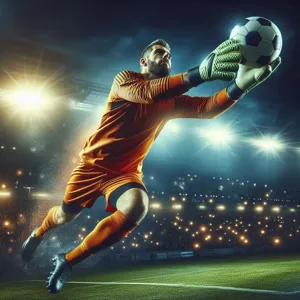
In the modern game of soccer, the role of the goalkeeper has transcended its traditional responsibilities, evolving into a pivotal component of high-press systems. Coaches are increasingly adopting aggressive pressing tactics that require their players, including the keeper, to engage in more dynamic roles during both defensive and offensive phases of play. Gone are the days when goalkeepers merely guarded the net; today, they are expected to be proficient with their feet, capable of initiating attacks, and skilled at reading the game.
In high-press systems, goalkeepers are often positioned higher up the pitch to enhance their teams’ overall pressing strategy. This positioning allows them to intercept passes and initiate quick counterattacks, turning defensive plays into offensive opportunities in the blink of an eye. For instance, when an opponent attempts to play out from the back, a modern goalkeeper must be agile and alert, ready to close down space and force mistakes. Their ability to act as a ‘sweeper-keeper’—a term that describes their proactive involvement in play—has become essential.
Moreover, with the emphasis on possession-based play, goalkeepers are now required to be comfortable with the ball at their feet. They must demonstrate excellent passing skills and vision, as they often become the first point of distribution. Whether it’s a quick short pass to a defender or a precise long ball to exploit spaces behind the opposition’s backline, the ability to read the game and execute under pressure is crucial.
In high-press systems, communication is another key aspect. Goalkeepers must orchestrate their defense, providing clear instructions to defenders about positioning and pressing triggers. This leadership role not only solidifies defensive organization but also helps maintain the team’s shape during transitions.
As the tactical landscape continues to shift, goalkeepers who adapt to these modern demands will not only enhance their own gameplay but also significantly contribute to their team’s overall success. Embracing the multifaceted role required of them today, these athletes are redefining what it means to be the last line of defense, proving that they are, in fact, integral to the entire team’s strategy.
8. The Role of Goalkeepers in Set Pieces: Defensive and Offensive Strategies
In the modern game of soccer, the role of the goalkeeper has transcended the traditional perception of merely being the last line of defense. With the evolution of tactics and strategies, goalkeepers now play a pivotal role during set pieces, both defensively and offensively. Their responsibilities extend beyond stopping shots; they are integral to the overall game plan, influencing the flow and outcome of matches.
**Defensive Strategies**
When it comes to defending against set pieces, goalkeepers must exhibit sharp awareness and command over their area. This means not only positioning themselves optimally to make a save but also organizing the defensive line. A skilled goalkeeper communicates effectively with defenders, ensuring they are aware of potential threats and marking assignments. For instance, during a corner kick, a goalkeeper’s ability to read the trajectory of the ball and anticipate the movements of opposing players is crucial. They must decide whether to punch the ball away, catch it cleanly, or rely on their defenders to clear the danger. This level of involvement requires a deep understanding of both the opponent’s tactics and the goalkeeper’s own team dynamics.
**Offensive Strategies**
On the flip side, goalkeepers are now being encouraged to contribute to offensive strategies during set pieces as well. When their team wins a free kick or corner, an agile and skilled goalkeeper can serve as a valuable asset. They can initiate quick counter-attacks by distributing the ball swiftly to teammates or even joining the attack during set pieces, providing an additional target in the opposition’s penalty area. Their ability to kick long or deliver precise passes can catch opponents off guard, turning a defensive situation into a scoring opportunity.
Moreover, goalkeepers are increasingly trained in set-piece scenarios where they become an effective part of the attacking play. Learning to time their runs for corner kicks or free kicks, they can capitalize on their height and reach, adding an unexpected dimension to their team’s strategy.
**The Modern Goalkeeper**
As the role of goalkeepers continues to evolve, they must be well-rounded athletes with excellent decision-making skills, agility, and a strong understanding of tactical play. Today’s goalkeepers are not just shot-stoppers; they are playmakers and leaders on the pitch, impacting both ends of the game. Their involvement in set pieces is a testament to how far the position has come, showcasing the multifaceted role they play in modern soccer. As teams adapt to the demands of contemporary play, the goalkeeper’s contributions during set pieces will undoubtedly become even more critical to achieving success on the field.
9. Mental Resilience: The Psychological Aspects of Goalkeeping
In the high-stakes arena of modern soccer, the role of a goalkeeper extends far beyond the physical demands of shot-stopping and positioning; it delves deep into the realm of mental resilience. Goalkeepers are often dubbed the last line of defense, but they are also the first to experience the psychological pressures that accompany the game. Each match is a test of mental fortitude, as they must continuously navigate the waves of anxiety, doubt, and pressure that come with the territory.
Imagine standing between the posts as the opposing team launches wave after wave of attacks, each moment fraught with the potential for failure. The mental toll can be immense. A single mistake—a misjudged cross, a fumbled save—can lead to a goal that changes the trajectory of the game and, in turn, the goalkeeper’s confidence. Successful goalkeepers develop robust coping mechanisms, relying on visualization techniques, breathing exercises, and a strong support system to bolster their mental strength.
Moreover, the ability to maintain focus amid chaos is a skill that sets elite goalkeepers apart. They must not only read the game as it unfolds but also anticipate the movements of players and the trajectory of the ball. This requires exceptional concentration and the capacity to remain calm and composed, even in the most intense situations. The mental aspect of goalkeeping also involves a great deal of self-talk, where positive affirmations can help mitigate the fear of making mistakes.
Additionally, modern goalkeepers are expected to be vocal leaders on the pitch, organizing their defense and communicating effectively with their teammates. This demands confidence and assertiveness, traits that are cultivated over time through experience and self-belief. As the game evolves, so too does the psychological landscape of goalkeeping, making mental resilience not just an asset, but a necessity for anyone aspiring to excel in this pivotal position.
In essence, the goalkeeper’s role is a delicate balance of physical prowess and psychological mastery, underscoring the importance of mental resilience in their journey from mere shot-stopper to a critical player in the beautiful game.
10. Technological Advancements: Analyzing Performance through Data
In the fast-paced world of modern soccer, technological advancements have fundamentally transformed how goalkeepers are trained, evaluated, and understood. Gone are the days when a goalkeeper’s performance was solely judged by the number of saves made or the goals conceded. Today, clubs and analysts leverage sophisticated data analytics to gain deeper insights into a goalkeeper’s performance, turning them into multifaceted players who contribute significantly to their team’s overall strategy.
With the advent of advanced tracking systems, such as GPS wearables and video analysis software, coaches can now dissect every movement and action of their goalkeepers in real time. Metrics such as shot-stopping efficiency, distribution accuracy, and even positioning during set pieces are meticulously analyzed. For instance, a goalkeeper’s ability to read the game and anticipate shots can be quantified using data points that track the trajectory of the ball and the goalkeeper’s response time. This level of scrutiny not only highlights their strengths but also identifies areas for improvement.
Moreover, the integration of video analysis software allows for detailed breakdowns of past matches, enabling goalkeepers to review their performances alongside their coaches. By examining specific scenarios, they can learn from mistakes and develop strategies to enhance their decision-making skills under pressure. This data-driven approach not only helps goalkeepers refine their technical skills but also boosts their confidence, knowing they have solid metrics backing their performance.
As teams continue to invest in technology, goalkeepers are no longer seen as merely the last line of defense; they have evolved into vital playmakers who initiate attacks with precise distribution and strategic positioning. The modern goalkeeper is expected to be comfortable with the ball at their feet, capable of making quick decisions that can shift the momentum of a match.
In this era where every detail is scrutinized, the role of the goalkeeper continues to evolve, embracing new technologies that not only enhance individual performance but also elevate the team’s chances of success. As data becomes an integral part of soccer, goalkeepers will undoubtedly continue to adapt and thrive, proving that they are much more than just a shield against opposing attacks.
11. Training Evolution: Modern Techniques for Goalkeepers
The evolution of training techniques for goalkeepers has transformed these players from mere shot-stoppers into dynamic, multifaceted athletes who play a crucial role in their team’s overall strategy. Gone are the days when goalkeeping was solely about reacting to shots; today’s keepers are expected to be adept at playing with their feet, reading the game, and even initiating attacks from the back.
Modern training regimens focus on a blend of physical conditioning, technical skill development, and mental acuity. Goalkeepers now engage in specialized drills that enhance their agility, reflexes, and overall athleticism. These sessions often include plyometric exercises that build explosive power, allowing them to make those crucial leaps and dives to thwart attempts on goal. Additionally, the use of advanced technology, such as video analysis and performance tracking software, provides invaluable feedback, allowing coaches and players to analyze every aspect of a goalkeeper’s game in detail.
Moreover, the tactical aspect of goalkeeping has become more pronounced. Goalkeepers are now trained to communicate effectively with defenders, organize the backline, and make quick decisions under pressure. This has led to a greater emphasis on situational awareness and positioning, as keepers must be prepared to act not just as custodians of the goal, but as playmakers who can turn defense into offense with a well-placed pass or a decisive clearance.
The integration of ball skills into goalkeeper training cannot be overstated. With the rise of the “sweeper-keeper” role, modern goalkeepers are increasingly required to participate in build-up plays and contribute to their team’s attacking prowess. Drills that simulate game scenarios, including distribution under pressure and playing out from the back, have become standard practice.
In essence, the training evolution of goalkeepers reflects the broader changes in soccer itself—a sport that demands versatility, intelligence, and adaptability from every player on the field. As the game continues to evolve, so too will the techniques and expectations placed on these pivotal players, ensuring that the role of the goalkeeper remains as dynamic as the sport itself.
12. The Impact of Coaching: Developing Goalkeepers for Today’s Game
The modern game of soccer has transformed the role of the goalkeeper from a mere last line of defense to a multifaceted player vital to a team’s overall strategy. This evolution is significantly influenced by innovative coaching methods that emphasize the importance of a goalkeeper’s skill set beyond traditional shot-stopping. Coaches today are focusing on developing goalkeepers who are not only adept at making saves but also possess strong distribution skills, tactical awareness, and the ability to initiate attacking plays.
In many training academies, goalkeepers are now treated as integral members of the team during practice sessions. Coaches are implementing drills that mimic game scenarios, allowing keepers to enhance their decision-making skills under pressure. This includes teaching them how to read the game, anticipate opponents’ movements, and understand the nuances of positioning. By integrating goalkeepers into small-sided games or possession drills, coaches help them cultivate a more robust understanding of the flow of play, further blurring the lines between player and goalkeeper.
Moreover, the rise of the “sweeper-keeper” role has prompted coaches to focus on agility, footwork, and ball control. Goalkeepers are now expected to play a pivotal role in building up play from the back, requiring them to be comfortable with the ball at their feet, capable of executing precise passes, and even venturing outside their box to clear threats. This shift in focus necessitates a different coaching approach—one that combines traditional shot-stopping techniques with modern skills training.
The impact of coaching extends beyond physical skills; it also encompasses mental resilience and confidence-building. Today’s goalkeepers are trained to handle the pressures of high-stakes situations, with coaches employing psychological techniques to foster a strong mindset. By instilling a sense of confidence and composure, coaches equip goalkeepers to thrive in the face of adversity, contributing to their overall performance on the field.
In summary, the role of the goalkeeper in modern soccer is evolving, and effective coaching is at the heart of this transformation. By prioritizing a well-rounded skill set that includes technical, tactical, and psychological training, coaches are ensuring that goalkeepers can meet the demands of today’s fast-paced game, ultimately redefining their impact on the field.
13. Notable Goalkeepers Who Changed the Game: Case Studies
In the landscape of modern soccer, certain goalkeepers have transcended their traditional role, redefining the expectations of what it means to guard the goal. These players have not only showcased outstanding shot-stopping abilities but have also emerged as pivotal figures in their teams’ tactical setups. Let’s delve into a few notable case studies that exemplify how goalkeepers have changed the game.
**1. Manuel Neuer: The Sweeper-Keeper Revolution**
When Manuel Neuer burst onto the scene, he brought with him a radical approach to goalkeeping that has since influenced a generation of players. Known for his exceptional reflexes and command of the area, Neuer redefined the role of a goalkeeper by becoming a proactive “sweeper-keeper.” His ability to play the ball with his feet and act as an additional defender allowed Bayern Munich and the German national team to adopt a more attacking style of play. Neuer’s knack for reading the game and his willingness to venture outside the penalty area have made him a quintessential example of how goalkeepers can contribute to both defense and offense.
**2. Alisson Becker: The Modern Day Playmaker**
Alisson Becker has further cemented the evolving role of goalkeepers by showcasing his passing prowess and composure under pressure. At Liverpool, Alisson has not only been a formidable presence between the posts but also a vital cog in the team’s build-up play. His ability to distribute the ball accurately over long distances has turned him into an unexpected playmaker, often initiating counter-attacks and linking up with midfielders and forwards. Alisson’s contributions go beyond mere shot-stopping; they’ve transformed the way his team approaches possession and attacking transitions.
**3. Ederson: The Goalkeeper as an Offensive Weapon**
For Manchester City, Ederson has taken the role of the goalkeeper to unprecedented heights. He is renowned for his pinpoint distribution, often launching precise passes that can dissect defenses and find strikers in advanced positions. His confidence with the ball at his feet allows City to maintain their high-pressing style, as he can quickly transition from defense to attack. Ederson’s unique skill set exemplifies the shift in goalkeeping, where the ability to contribute offensively is just as crucial as traditional shot-stopping.
These goalkeepers are not just defenders of their goals; they are key players who enhance their teams’ overall strategies. By embracing the dual role of shot-stopper and playmaker, they have paved the way for future generations of goalkeepers to rethink their contributions to the game. In an era where every player’s role is increasingly interconnected, the modern goalkeeper stands out as an essential cornerstone of tactical innovation in soccer.
14. Future Trends: What Lies Ahead for Goalkeepers in Soccer
As the game of soccer continues to evolve, so too does the role of the goalkeeper. No longer confined to merely stopping shots and organizing the defense, modern goalkeepers are becoming integral to their teams’ attacking strategies. A glance into the future reveals several trends that are likely to shape the position in the coming years.
One prominent trend is the increasing emphasis on goalkeepers as playmakers. With the rise of possession-based tactics, goalkeepers are expected to be adept with their feet, capable of playing precise passes and initiating attacks from the back. This shift has led to the development of specialized training programs focusing on footwork, distribution skills, and decision-making under pressure. Coaches are now looking for goalkeepers who can read the game, anticipate opposition movements, and contribute to build-up play, effectively transforming them into an additional outfield player.
Moreover, technology is playing a crucial role in this evolution. Video analysis, performance metrics, and advanced analytics are becoming staples in goalkeeper training regimes. Goalkeepers are now using data-driven insights to refine their positioning, improve their shot-stopping techniques, and enhance their decision-making processes. The integration of wearable technology, such as GPS trackers and heart rate monitors, allows for real-time feedback, enabling goalkeepers to optimize their physical conditioning and in-game performance.
Another significant trend is the changing physical attributes of goalkeepers. As the game becomes faster and more dynamic, agility and athleticism are becoming paramount. The ideal modern goalkeeper is not only tall and strong but also possesses exceptional reflexes and quick footwork. Emphasis on agility training, flexible movement patterns, and explosive power is reshaping how young goalkeepers are nurtured. We may even see a future where goalkeepers are trained cross-discipline, incorporating elements from sports like basketball and volleyball to enhance their aerial ability and spatial awareness.
Lastly, the psychological aspect of the goalkeeper’s role is gaining increased recognition. The mental resilience required to handle high-pressure situations is more crucial than ever. Future goalkeepers will likely benefit from psychological training that helps them manage stress, maintain focus, and develop a strong mindset. As the pressure of the modern game intensifies, goalkeepers who can remain composed and confident in the face of adversity will stand out as the leaders of their teams.
In summary, the future of the goalkeeper position in soccer promises to be dynamic and multifaceted, marked by an emphasis on versatility, technological integration, physical prowess, and mental fortitude. As the role continues to evolve, those who can adapt and innovate will not only redefine their position but also elevate the entire game.
15. Conclusion: Embracing the Multifaceted Role of the Modern Goalkeeper
As we reflect on the evolving role of the goalkeeper in modern soccer, it’s clear that these players have transcended their traditional duties. No longer merely the last line of defense, goalkeepers are now pivotal figures who influence the game from the backline, shaping both defensive strategies and attacking plays. Their ability to read the game, communicate effectively with defenders, and make split-second decisions under pressure is more critical than ever.
Today’s goalkeepers are not just shot-stoppers; they are playmakers, capable of initiating attacks with precise distribution and smart positioning. The rise of the “sweeper-keeper” has redefined the expectations placed on these athletes, requiring them to be comfortable with the ball at their feet and adept at participating in the build-up play. This shift emphasizes the importance of technical skills and tactical awareness, making the role of the goalkeeper a multifaceted one that demands a unique blend of attributes.
As we embrace this new era, it’s essential for coaches, teams, and aspiring goalkeepers to recognize and cultivate the diverse skills required for success. Training programs must adapt, focusing not only on traditional shot-stopping techniques but also on honing passing accuracy, decision-making, and overall game intelligence. The modern goalkeeper must be prepared to face the challenges of an ever-evolving game, where adaptability and versatility are paramount.
In conclusion, the goalkeeper’s role is a testament to the dynamic nature of soccer itself. As the sport continues to evolve, so too must the players who guard the goal. By embracing this multifaceted approach, we can appreciate the depth and complexity of the goalkeeper’s position, celebrating their contributions to the beautiful game beyond mere saves and statistics. The future of goalkeeping is bright, and those who rise to the challenge will undoubtedly leave a lasting mark on the sport.
In conclusion, the role of the goalkeeper in modern soccer has transformed dramatically, evolving from merely a last line of defense to a dynamic playmaker integral to a team’s overall strategy. By embracing responsibilities such as ball distribution, communication, and even participating in the build-up play, today’s goalkeepers are redefining their position on the field. As the game continues to evolve, so too will the expectations and skills required of these athletes. Whether you’re a player, coach, or fan, recognizing and appreciating this multifaceted role will deepen your understanding of the game and its complexities. As we watch the beautiful game unfold, let’s celebrate the goalkeepers who are daring to break the mold and shape the future of soccer with their innovative contributions.


